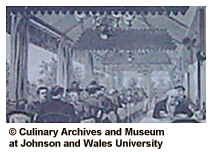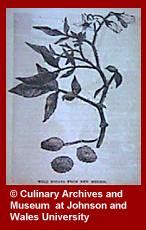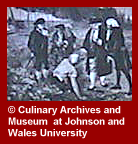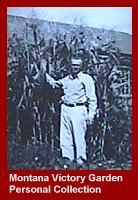Potatoes: prominent in peace and critical during wartime. Potatoes, whether baked or boiled, dehydrated or fried, have presented opportunities to American chefs for more than 200 years. American inventiveness created the potato chip, and what high-energy breakfast is complete without hash-browns? Nearly 460 million pounds of potatoes reach American markets yearly, and Americans on average eat 49 pounds of potatoes per year. No controversial "hot potato" here: potatoes are good high energy foods!
HOW TO COOK A WOLF
One of the most interesting American books to emerge during World War II was M. F. K. Fisher's classic work, How To Cook a Wolf, (1942). Fisher provided numerous suggestions that ranged from how to cope with rationing, to the storage of food in bomb shelters. Her writing style was witty, and designed to "keep the wolf from the family door." Fisher was an important educator who taught careful food planning. Her social observations were also sharp
Potatoes are one of the last things to disappear in times of war . . . they should not be forgotten in times of peace.
One of the best endings to a supper is nothing at all. If the food has been simple, plentiful, and well prepared, if there has been time to eat it quietly, with a friend or two, then more often than not, most people will choose to leave it so, with perhaps only a little cup of coffee for their souls' sake
Fisher is best known, however, for her famous War Cake Recipe, a dessert designed to help families get through the hard times . . .
[8: 1]
Did You Know?

|
INVENTION OF THE POTATO CHIP:
While dining at Moon's Lake House, Saratoga Springs, New York, a finicky patron repeatedly returned his order of french fried potatoes. Chef George Crum became enraged, sliced some of the potatoes paper-thin, returned the plate to the guest, who loved them, and the potato chip was born. [8:6] |
|

HISTORY OF THE POTATO
White potatoes were domesticated in highland South America, exported to Spain, and appear in European books after 1553. Irish immigrants introduced the white potato to North America probably in 1719, but became field crops at Salem, Massachusetts, only after 1762. First American cookbook potato recipes date to 1857. [8:3]

FOOD IN AMERICAN INTERNMENT CAMPS:
At noon we have soup, rice, salad and perhaps beans. For dinner there is meat or fish, and cake, pie, or pudding... [When] I see the elderly meekly eating what is offered them... my eyes become warm.
Hatsuye Egami
Tulare [California] Assembly Center, 1942
[8:5]

CHICKEN, DEATH AND POTATOES
Sundays we always had chicken; not so much roast chicken, but boiled or fried in different ways. I remember once when some of my family died, people came for miles around and it was a custom to put baked potatoes in the coffin.
Marie Haggerty [8:7]

VICTORY GARDENS AND RETURN TO THE LAND
Before World War II urban Americans had grown accustomed to soft, canned foods - the "modern" way to eat vegetables. The backyard Victory Gardens of World War II reminded Americans of the joys of eating produce -- fresh from their own garden. As a result, crisp, raw vegetables regained popularity. [8:4]
|





